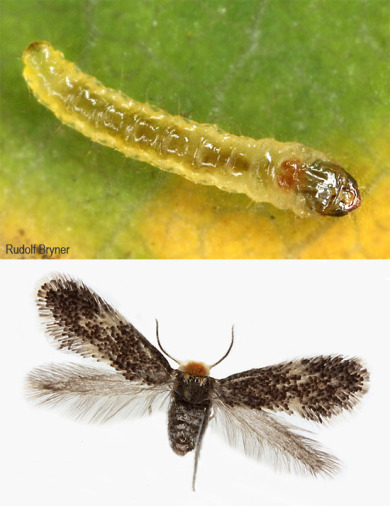 Yellow and brown and down to earth, they might appear dead. But they are not quite dead. They are the undead: zombie aspen leaves.
Yellow and brown and down to earth, they might appear dead. But they are not quite dead. They are the undead: zombie aspen leaves.
Find them as you walk the brown autumn paths – yellow leaves with a patch of green tissue radiating from the base of the midrib. Here in Vermont, these are mostly Quaking Aspen (Populus tremuloides), but I also find the green on Big-toothed Aspen (P. grandidentata) and, rarely, Eastern Cottonwood (P. deltoides).
I first encountered these some years ago. I collected a few and queried a handful of smart botanists for answers. Many had theories; none had an explanation. It wasn’t until I put a leaf under a dissecting microscope that I found it to be less zombie than something from the film “Alien.” The beast lies within.
Residing in a tiny pocket of tissue near the base of the green patch is a translucent caterpillar not  much more than 2 millimeters in length. It’s feeding in there; I could see the frass (caterpillar poop). With help from Dave Wagner, the renowned entomologist at the University of Connecticut, our critter turns out to be a moth in the family Nepticulidae, probably Ectoedemia argyropeza or most certainly a member of that genus.
much more than 2 millimeters in length. It’s feeding in there; I could see the frass (caterpillar poop). With help from Dave Wagner, the renowned entomologist at the University of Connecticut, our critter turns out to be a moth in the family Nepticulidae, probably Ectoedemia argyropeza or most certainly a member of that genus.
“The really cool thing is that the larva secretes an anti-senescent substance that keeps part of the leaf alive – probably a cytokinin,” Dave wrote in an email. Cytokinins are plant hormones that promote cell division. In this case, it seems, the caterpillar keeps part of a leaf alive so that it can keep eating.
This moth is also parthenogenetic; females can produce fertile eggs without help from males, which, as it turns out, are quite rare.
For now, however, the caterpillar will continue to dine in the verdant patch of an otherwise dead leaf. It will pupate for winter. And the tiny adult will emerge to fly in spring. Many species in this genus are black and white with orange scales around the head. But don’t expect to find one. Your best bet for discovering this animal is to watch the trail for patterns in aspen leaves this fall.
Bryan Pfeiffer is a VCE research associate who blogs at www.bryanpfeiffer.com.

Amazing! Thanks for sharing your discovery!